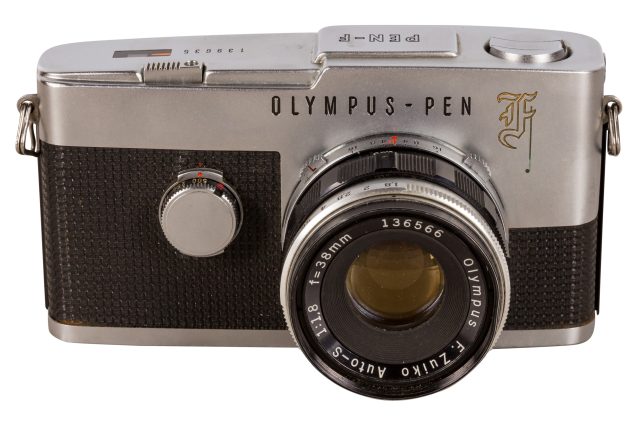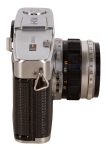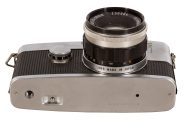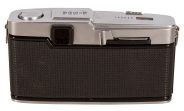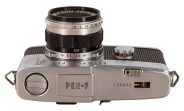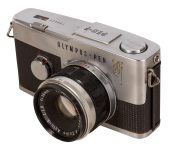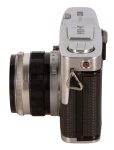Announced
System
Olympus Pen F system cameras
Olympus Pen F
Half frame MF film SLR camera
Specification
| Format: | |
| Half frame | |
Film type: | 135 cartridge-loaded film |
| Olympus Pen F [28.95mm] | |
| Shutter: | |
Type: | Focal-plane |
Model: | Mechanical |
Speeds: | 1 - 1/500 + B |
| Exposure: | |
Exposure metering: | None |
Exposure modes: | Manual |
| Physical characteristics: | |
Weight: | 560g |
Dimensions: | 127x69.5x62.5mm |
Manufacturer description #1
Why do famed photographers like W. Eugene Smith pick 'Pen-F' for varied assignments?
Because it’s the only single frame SLR system! And because the heart of the system, the Pen-F camera, is a highly precise, miniaturized giant of a working tool. For the first time in SLR history, the advantages of thru-the-lens viewing and focusing, automatic-diaphragm lens interchangeability, all the versatility of the SLR are available without the traditional bulkiness and weight of the SLR. Pen-F introduces the Porro-prism, a giant step forward in SLR design. This eliminates the bulge and bulk of the old-fashioned penta prism, and produces a viewfinder image whose brightness is second to none. You barely know you’re looking through a camera when you view your subject! Other natural advantages of Pen-F are the compactness and light weight of the lenses and other components comprising the Pen-F System. And, of course, the significant economy of the single frame format that produces twice the number of top quality slides or negatives on a standard 35mm film roll. Made possible by the great strides of recent years in the quality of film emulsions.
The Pen system offers a full lens range from 25mm to a mirror-reflex 800mm, plus an unusual 50-90mm zoom that rivals the sharpness of the finest lens throughout its zoom range. Bellows, Slide Copier, Camera Rails, Extension Ring, Close-up Attachment, Camera Mount, Microscope Attachment, Slide Projector, and a host of other useful accessories round out the System for the serious photographer. Pen-F, with Automatic 38mm f1.8 lens is less than $140.00. With 40mm f1.4 Automatic lens, less than $170.00.
Manufacturer description #2
FILM SIZE: 24x18 mm ("Pen" size).
LENS: Standard lens: F Zuiko Auto S, F 1.8 f=38 mm
LENS MOUNT: Bayonet type (Pen mount).
SHUTTER: Olympus rotary metal focal-plane shutter with single-pivot, non-revolving shutter dial. Synchronized for electronic flash use. B. 1-1/500 sec., equally calibrated. X setting.
FINDER: Through-the-lens type. Image magnification 0.8 X. Porroprism system with Fresnel lens.
FOCUS ADJUSTMENT: Specially computed focusing lens with 5 X magnifier.
MIRROR: Horizontally revolving, quick return.
FILM ADVANCING: Double action with 90° self-cocking lever. Double exposure impossible. Self resetting type film counter.
REWINDING: Crank system with rewind release button.
REAR COVER: Hinge system with release built into rewind knob.
From the Classic Camera magazine (February 2000)
In 1963, Olympus hit the mark with the presentation of the first and only 35mm reflex with interchangeable lens ever created in half frame. Following in the footsteps of its successful predecessor, it was called the Olympus Pen F, the added "F" standing for Flex. The "F" was considered so important that it was engraved as a gothic capital letter on the camera front. The choice of a gothic letter on a Japanese camera was unusual, but it was not the only example. Before the Pen F, the Petri V6 had been marked with a gothic V, and following the Pen F, a gothic letter was utilized on the Cosina Hi-Lite and Yashica TL Electro X.
Just as the small Olympus Pen with normal finder eyepiece was the product of its own unique design without imitating larger cameras, so the Olympus Pen F was born without imitating any of the reflex cameras of its day. The Pen F does not resemble in the least the characteristic appearance of any of the contemporary Japanese reflexes including the Nikon F, Asahi Pentax, Minolta SR or Canon. The technological choices behind this incomparable camera are also completely unique, seen in the shutter, the way the image is reflected in the finder, its winding lever and shutter release button.
The small Olympus Pen F has a flat, elongated body that gives no hint of the movable mirror it houses.The machine body is only 13cm long and 7cm high, and apart from the parts that extend outside the basic contour, has a width of only 3.5cm that reaches just over 4cm if the eyepiece and shutter speed setting on the front are included. The camera, without lens, weighs 430 grams.
The camera body is thickest in the middle and tapers off at the edges. It has rounded corners and the top plate is completely flat without accessory clip and adorned with just light molding that highlights the parts of the camera. The front is totally flat, and finished in chrome with a black body covering.
The lens changing catch is decidedly positioned off-center towards the left and engraved above it is the inscription "Olympus Pen" followed by the prominent gothic "F". The name "PEN-F" is also inscribed on the top plate in capital letters with a thin black border. Except for the shutter speed setting (ranging from a second to 1/500s) located on the front to the right of the lens and extending almost a centimeter from the body, all controls are incorporated within the camera's profile. The winding lever is built into the back as in many pocket cameras of that era, and juts out only the minimum required to engage it. The extendable rewind knob is completely recessed into the top plate and the uniquely rectangular shape shutter release button is threaded for the flexible shutter release and is flush with the top plate profile.
The hinged back is opened by lifting the rewind knob. The Olympus Pen F does not have a self-timer mechanism and, as in the early Leica M3, the shutter tensioning and film advance require the rapid winding lever to be cocked twice.
The shutter of the Olympus Pen F is located on the focal plane and is of a rotating type with diaphragm. It is a bit reminiscent of those used in movie cameras and the German Robot camera and allows for 100% synchronization with all shutter speeds.
The image framed by the lens is not sent to the viewfinder using a traditional pentaprism, but rather through a complex system of mirrors and prisms that provide an upright image thanks to a series of multiple reflections. All the components of the reflex viewfinder are housed within the reduced width of the camera without causing unsightly bulges. A viewing system similar, but not identical, to that of the Olympus Pen F had been adopted several years earlier by the French Focaflex for its 24x36mm format.
The Olympus Pen F does not have a built-in exposure meter, but could be equipped with a unique external meter that had a sensitive CdS photocell and could be coupled with the speed control. The accessory clip was also separate and could be inserted into the side guides of the finder frame. A single cable release socket located on the left side of the camera could be switched from M to X.
Production of the Olympus Pen F began in September 1963 and continued until July 1966 when the camera was replaced on the assembly line by an improved model to keep pace with market demand and trends.
From the editor
The weight and dimensions are indicated for the camera body with the standard lens.
